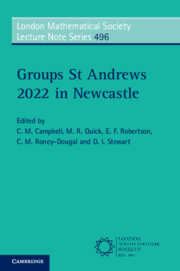Book contents
- Frontmatter
- Contents
- Introduction
- 1 Finite group schemes
- 2 Algorithms for polycyclic groups
- 3 The spread of finite and infinite groups
- 4 Discrete subgroups of semisimple Lie groups, beyond lattices
- 5 Complete reducibility and subgroups of exceptional algebraic groups
- 6 Axial algebras of Jordan and Monster type
- 7 An introduction to the local-to-global behaviour of groups acting on trees and the theory of local action diagrams
- 8 Finite groups and the class-size prime graph revisited
- 9 Character bounds for finite simple groups and applications
- 10 Generalized Baumslag-Solitar groups: a topological approach
- References
7 - An introduction to the local-to-global behaviour of groups acting on trees and the theory of local action diagrams
Published online by Cambridge University Press: 21 November 2024
- Frontmatter
- Contents
- Introduction
- 1 Finite group schemes
- 2 Algorithms for polycyclic groups
- 3 The spread of finite and infinite groups
- 4 Discrete subgroups of semisimple Lie groups, beyond lattices
- 5 Complete reducibility and subgroups of exceptional algebraic groups
- 6 Axial algebras of Jordan and Monster type
- 7 An introduction to the local-to-global behaviour of groups acting on trees and the theory of local action diagrams
- 8 Finite groups and the class-size prime graph revisited
- 9 Character bounds for finite simple groups and applications
- 10 Generalized Baumslag-Solitar groups: a topological approach
- References
Summary
The primary tool for analysing groups acting on trees is Bass--Serre Theory. It is comprised of two parts: a decomposition result, in which an action is decomposed via a graph of groups, and a construction result, in which graphs of groups are used to build examples of groups acting on trees. The usefulness of the latter for constructing new examples of `large (e.g.~nondiscrete) groups acting on trees is severely limited. There is a pressing need for new examples of such groups as they play an important role in the theory of locally compact groups. An alternative `local-to-global approach to the study of groups acting on trees has recently emerged, inspired by a paper of Marc Burger and Shahar Mozes, based on groups that are `universal with respect to some specified `local action. In recent work, the authors of this survey article have developed a general theory of universal groups of local actions, that behaves, in many respects, like Bass--Serre Theory. We call this the theory of local action diagrams. The theory is powerful enough to completely describe all closed groups of automorphisms of trees that enjoy Tits Independence Property $\propP{}$. This article is an introductory survey of the local-to-global behaviour of groups acting on trees and the theory of local action diagrams. The article contains many ideas for future research projects.
- Type
- Chapter
- Information
- Groups St Andrews 2022 in Newcastle , pp. 295 - 340Publisher: Cambridge University PressPrint publication year: 2024

